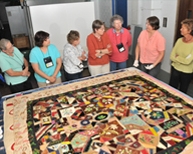Catching History Before it Disappears
- Marsha MacDowell, Ph.D.
- Professor, Art and Art History
- Curator of Folk Arts, MSU Museum
You might think of museums as repositories for the dusty detritus of times past. Marsha MacDowell would disagree. At the MSU Museum, where Dr. MacDowell is curator of folk arts, "we are moving to get more contemporary materials," she said. "We focus on the understudied, underdocumented cultures of today. We want to catch them before they disappear."

Members of the Michigan Quilt Network view quilts from the MSU Museum's quilt collection. Folk arts curator Marsha MacDowell (far right) and collections assistant Beth Donaldson (next to MacDowell) explain that the quilt was made by Lois Darcus, of Elsie, Michigan, between 1876 and 1900.
The Story is Part of the Artifact
A case in point is quiltmaking. The art of quiltmaking interests MacDowell because it has so many cultural overtones—ethnic, artistic, social, political, and feminist. She is working with the Alliance for American Quilts and MSU's MATRIX — Center for Humane Arts, Letters, & Social Sciences Online to document the stories of quilt makers, collectors, scholars, and others who were instrumental in the 20th century quilt revival. The Quilt Treasures project is making this documentation available online, through Web portraits and mini-documentaries. "The Alliance decided who were the key people they wanted to interview," said MacDowell. "I go to the person's home, studio, or other workplace and do the interview."
The Quilt Treasures Web portraits go beyond simple videos. "The interviews are indexed," said MacDowell. "We worked with local teams, including people who knew the quilter, to develop question lists that were geared for target audiences, including educators, artists, and scholars. We asked some of the same questions across the interviews, such as 'What is a quilt for?' and 'What are your earliest quilting memories?', so that the responses could be compiled across artists." Users of the site can click on a question to hear how different artists answered it. The Web portraits also use still photos, comments from friends or associates of the artist, and even poetry to capture the subject. The project has completed 13 interviews to date, eight of which have been produced as full Web portraits.
Scholar-Directed and Volunteer-Driven
"Our projects are scholar-directed and volunteer-driven," said MacDowell. "Groups come to us and we train them to do the intake. Our goal is to get more students and the public involved with documentation and analysis of the materials, and then to make the materials and the analyses available and searchable. There are amazing inventories of material culture available for research—quilts, baskets, stained glass, barns, and other forms."
MacDowell and her colleagues at the MSU Museum have evolved something of a template for working with artist/historian associations like the quilters.
First, you connect with an existing collaboration, like the quilters' association. Then, you put it to work. "For the Michigan Stained Glass Census, volunteers all over the state register stained glass in their community," said MacDowell. "You can fill in a survey form and submit photos online. We have been collecting data for 15 years. We now have about 1,100 buildings registered and are adding information about the designers and makers of the windows. MATRIX is helping Museum research associate Dr. Betty MacDowell, the census director, to make the database searchable."
A similar method drives the Michigan Barn & Farmstead Survey, a collaborative project with Michigan Barn Preservation Network coordinated by LuAnne Kozma, assistant curator of folk arts at the Museum. Volunteers travel the back roads in their township, taking photographs and filling out a survey form for each farmstead.
"It's not just about collections at the Museum," said MacDowell. "It's also about inventorying and cataloging what's out there." The Museum recently submitted a major research proposal with the the American Folklife Center/Library of Congress and the American Folklore Society to fund a national ethnographic archive initiative; the MSU Museum's Traditional Arts Research Collections will serve as one of five national test beds.
The Michigan State University Museum was founded in 1857 and is one of the oldest museums in the Midwest. In 2001 the MSU Museum became the first museum in the state to receive affiliate status from the Smithsonian Institution in Washington, DC.
- Written by Linda Chapel Jackson, University Outreach and Engagement
- Photograph by Paul Phipps, University Outreach and Engagement